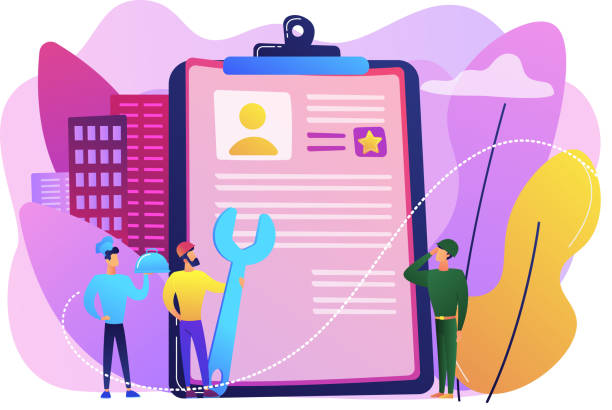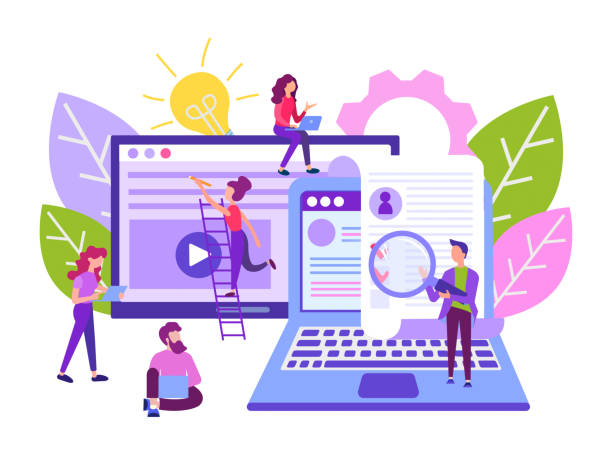Why Website Speed is Crucial

In today’s digital world, where users expect to receive information in the shortest possible time, fast website design is no longer a competitive advantage, but a necessity.
When a user enters your website, every millisecond of delay can mean losing them.
Studies have shown that most users prefer web pages to load in less than three seconds, otherwise, they abandon the page.
This issue not only affects user experience (UX) but also directly impacts your conversion rate and ultimately your business’s revenue.
Low loading speed can lead to an increased Bounce Rate and decreased content engagement.
This section explanatorily and analytically examines various aspects of website speed’s importance and helps you gain a deeper understanding of the consequences of a slow website.
Imagine your competitor has a super-fast website and you don’t; this is a clear #competitive_failure.
Fast website design actually means providing a flawless user experience that leads to customer satisfaction and loyalty.
This is the first step towards online success.
Are you worried about your e-commerce website’s low conversion rate and not achieving your desired sales?
Rasaweb, your specialized solution for a successful e-commerce website.
✅ Significant increase in conversion rate and sales
✅ Professional and user-friendly design to attract customer satisfaction
⚡ Ready for a transformation in online sales? Get a free consultation!
Key Factors Affecting Website Slowness

To achieve fast website design, one must first identify the main factors that slow down a website.
This section expertly and educationally examines these factors.
One of the most common reasons is the large size of images and videos with unsuitable quality that are loaded without optimization.
Every large image or video can significantly increase page loading time.
Furthermore, excessive use of JavaScript scripts and CSS files that are not properly minified and combined imposes an additional burden on the user’s browser.
Choosing inappropriate hosting and slow servers is another important factor; an overloaded shared host can severely reduce your website’s speed.
Lack of database optimization, the presence of too many inefficient plugins in content management systems like WordPress, and the absence of proper caching can all contribute to your website’s slowness.
Understanding these factors is the first step towards fast website design.
Each of these issues must be carefully examined and addressed for your website to achieve its best performance.
This technical knowledge helps you make more informed decisions when optimizing your website.
Techniques for Image Speed Optimization and Caching

One of the most effective ways for fast website design is optimizing images and implementing caching mechanisms.
This section provides guidance and specialized information.
For images, always use optimized formats like WebP, which offer higher compression while maintaining quality.
Various online tools and plugins are available for compressing images without significant loss of quality.
Using “Lazy Loading” for images and videos is crucial; this technique ensures content is loaded only when the user scrolls to that part of the page, not from the very beginning.
This is especially useful for pages with a lot of content.
Regarding caching, there are two main types: Browser Caching and Server Caching.
Browser caching allows the user’s browser to store static files (such as CSS, JavaScript, images) for subsequent visits, eliminating the need to re-download them.
Server-side caching also stores database responses and dynamic pages to be delivered faster in subsequent requests.
Using caching plugins like WP Rocket for WordPress or enabling caching in server settings (such as Varnish or Redis) can make a significant difference in your website’s speed and greatly contribute to fast website design.
In the table below, you can see image optimization strategies:
| Strategy | Description | Benefits |
|---|---|---|
| Lossless Compression | Reduces file size without significant visual changes | Reduces loading time, saves bandwidth |
| Use of Modern Formats (WebP) | Formats with higher compression and good quality | Significant reduction in file size, supported by modern browsers |
| Lazy Loading | Loads images only when they are in the viewport | Increases initial page load speed, improves performance |
| Correct Image Sizing | Using dimensions proportionate to the display area | Prevents resizing by the browser, reduces size |
Code Optimization, CDN Usage, and GZIP Compression

Continuing the path to fast website design involves deeper code optimization and the use of more advanced technologies.
This section provides guidance and specialized information on these topics.
Minification of CSS and JavaScript files means removing whitespace, comments, and extra characters, which reduces file sizes without changing functionality.
Concatenating these files also reduces the number of HTTP requests to the server, which in turn increases loading speed.
Using a CDN (Content Delivery Network) is another powerful solution.
CDNs store copies of your website’s static content on various servers worldwide.
When a user visits your site, the content is delivered from the CDN server closest to them, which significantly reduces latency and increases loading speed.
Enabling GZIP compression on the server is also essential.
GZIP compresses HTML, CSS, and JavaScript files before sending them to the browser, which significantly reduces the amount of data transferred.
These techniques, together, can have a tremendous impact on your site’s overall performance and ensure a fast website design.
Proper implementation of these requires technical knowledge, but the results are well worth the investment.
Frustrated with your e-commerce website’s low conversion rate? Rasaweb transforms your online store into a powerful tool for attracting and converting customers!
✅ Significant increase in visitor-to-buyer conversion rate
✅ Unparalleled user experience to boost customer satisfaction and loyalty⚡ Get a free consultation from Rasaweb!
Speed Measurement and Performance Analysis Tools

After implementing changes for fast website design, you need to measure and analyze your website’s performance.
This section, in an educational and guidance format, introduces practical tools.
The most popular tools include Google PageSpeed Insights, GTmetrix, Pingdom Tools, and WebPageTest.
Each of these tools provides detailed reports on your website’s loading speed and identifies strengths and weaknesses.
Google PageSpeed Insights gives you a score from 0 to 100 for desktop and mobile speed and offers suggestions for improvement.
GTmetrix also provides comprehensive information on loading time, number of requests, page size, and optimization scores, using metrics like YSlow and PageSpeed.
Pingdom Tools shows the overall loading time and helps you identify slow files.
WebPageTest also offers more advanced features, including testing from various geographical locations and simulating different internet speeds.
Regular use of these tools allows you to monitor the changes implemented and make further optimizations if needed.
These tools are essential for anyone involved in fast website design.
Impact of Website Speed on SEO and Google Ranking

Website speed is one of the important factors in Google’s ranking algorithm and has a direct impact on SEO.
This section addresses this topic analytically and expertly.
Since 2010, Google has officially announced that page loading speed would be one of the main criteria in search results ranking, especially for the mobile version.
Websites that load faster offer a better user experience, resulting in lower bounce rates and longer user dwell time on their sites.
These signals are considered positive by Google and help your site rank higher.
Additionally, search engines have a limited Crawl Budget for each site.
Slower sites consume more crawl budget, and as a result, fewer of their pages may be indexed by Google’s crawlers.
This could mean losing opportunities for display in search results.
Therefore, for any business looking to be visible online, fast website design is an essential SEO investment.
This not only increases organic traffic but also builds user credibility and trust.
Website speed optimization is a long-term strategy for improving SEO and sustainable growth in the digital space.
The Role of Speed in User Experience and Conversion Rate

Beyond SEO, fast website design has a significant impact on user experience (UX) and ultimately the conversion rate.
This section explores this relationship through thought-provoking content and analysis.
Did you know that even one second of delay in page loading can reduce your conversion rate by up to 7%? This means if your site generates $100,000 in annual revenue, you lose $7,000 with just one second of delay! Today’s users are more impatient than ever.
When a site is slow, it not only creates a negative user experience but also reduces user trust in the brand.
A slow site can cause users to turn to your competitors.
Nielsen Norman Group, UX specialists, believe that users tolerate up to 10 seconds of delay, but the faster the speed, the higher the user satisfaction.
High speed allows users to navigate the site more easily, view more content, and ultimately are more likely to perform your desired action (purchase, registration, contact).
A high-speed website gives users the impression that your website is professional, reliable, and up-to-date.
This positive feeling directly leads to customer loyalty and increased sales.
In the table below, you can see the impact of page speed on user experience and conversion rate:
| Metric | Impact of Low Speed | Impact of High Speed |
|---|---|---|
| Bounce Rate | Significant increase (up to over 30%) | Significant decrease, users stay longer on the site |
| Conversion Rate | Noticeable decrease (up to 7% per second of delay) | Increase (users more easily make purchases or sign up) |
| User Satisfaction | Sharp decrease, negative experience | Increase, positive and enjoyable experience |
| Organic Traffic | Decrease due to lower search rankings | Increase due to higher search rankings |
Choosing Suitable Hosting and Its Impact on Performance

One of the most important decisions on the path to fast website design is choosing suitable hosting.
This section provides guidance and specialized information on various types of hosting and their impact on website speed.
Shared hosting is often the cheapest option, but server resources are divided among many websites, which can lead to decreased speed during peak hours.
It might be suitable for small and new websites, but for long-term growth, better options exist.
VPS (Virtual Private Server) offers more dedicated resources and gives you more control over the server environment, leading to higher speed and stability.
Dedicated Servers allocate all resources of a physical server to you, providing the highest level of performance and control, but they are more expensive and require more technical knowledge.
Cloud Hosting is also a flexible and scalable option that provides resources from a network of servers and can be very suitable for variable traffic.
When choosing hosting, pay attention to factors such as SSD disks, HTTP/2 support, data center location (proximity to your audience), and support for NGINX or LiteSpeed instead of Apache.
Good hosting provides a strong foundation for a high-speed website.
Did you know that a weak corporate website costs you many opportunities daily? Solve this problem forever with professional corporate website design by Rasaweb!
✅ Creating a powerful and trustworthy image for your brand
✅ Targeted attraction of new customers and increased sales
⚡ [Get a free website design consultation]
Importance of Responsive and Mobile-First Design in Speed

With the increasing number of mobile users, fast website design must include a Responsive Design and Mobile-First approach.
This section explains and specializedly clarifies the importance of these two concepts.
Responsive design means that your website automatically adapts to the screen size of the user’s device, whether it’s a desktop, tablet, or smartphone.
This ensures that the visual and functional experience is consistent and optimized across all devices.
The mobile-first approach, also recommended by Google, means that in the design and development process, we first consider the user experience on mobile devices and then expand it for desktop.
This approach is particularly crucial for speed, as designing for mobile inherently leads to lighter and more optimized code that loads faster.
Many websites are designed with a desktop-first approach and then optimized for mobile, which often leads to loading extra code and slowness on mobile.
With a mobile-first approach, you focus on speed optimization principles from the outset, and the results will be evident across all devices.
A fast website design on mobile means better SEO and a superior user experience for a large portion of your audience.
Importance of Maintenance and Updates for Speed Preservation

The path to fast website design is not a one-time process, but requires continuous maintenance and updates.
This section addresses the importance of this topic in a news and educational format.
Web technologies are rapidly changing, and search engine algorithms are constantly being updated.
Therefore, to maintain website speed and optimal performance, you must regularly update your CMS software (like WordPress), plugins, and themes.
These updates often include security enhancements, bug fixes, and performance improvements that contribute to site speed.
Also, you should regularly optimize your database, remove unused plugins and code, and delete old and unnecessary content.
Monitoring website performance using the tools introduced in previous sections is also essential to quickly identify and resolve any speed drops.
Investing in preventative maintenance is far more efficient than fixing major problems after they occur.
Also, keep an eye on news and updates in the field of web performance.
A high-speed website is the result of continuous commitment to optimization and technical hygiene, which directly impacts your business’s long-term success.
Frequently Asked Questions
| Row | Question | Answer |
|---|---|---|
| 1 | What does fast website design mean? | Fast website design means optimizing the website design and development processes so that the final result (the website) is ready for use in the shortest possible time, while maintaining quality and efficiency. This includes using efficient tools, templates, and techniques. |
| 2 | Why is speed important in website design? | Speed in website design is important because customers usually have an immediate need for an online presence. Additionally, longer projects can be more costly and delay business opportunities. Faster website delivery contributes to customer satisfaction and competitive advantage. |
| 3 | What tools help with fast website design? | Content Management Systems (CMS) like WordPress, Joomla, or Drupal, the use of CSS frameworks like Bootstrap or Tailwind CSS, Page Builders like Elementor or Visual Composer, and Rapid Application Development (RAD) tools help with fast design. |
| 4 | Does using pre-made templates affect fast design? | Yes, using ready-made and standard templates has a very significant impact on fast design. These templates are pre-designed and only require customization of content, color schemes, and images, which drastically reduces development time. |
| 5 | What is the role of CMS (Content Management System) in fast website design? | CMSs play a key role in accelerating the website design and development process due to providing a graphical user interface, eliminating the need for deep coding for most operations, the availability of ready-made plugins and themes, and the possibility of easy content editing. |
| 6 | Does high design speed reduce the final quality of the website? | Not necessarily. If standard and optimized methods, tools, and templates are used, a high-quality website can be designed in a short time. The knowledge and experience of the design team are also very effective in maintaining quality. |
| 7 | What tips are important for accelerating customer communication in website design? | Having a clear and defined process for requirements gathering, using standard forms for content submission, setting realistic deadlines, and holding focused and efficient meetings can accelerate customer communication. |
| 8 | What is the effect of image optimization on website loading speed after design? | Image optimization (file compression, use of appropriate formats like WebP) reduces the overall size of website pages. This reduction in size helps browsers download and display pages faster, which improves the user experience. |
| 9 | Is suitable hosting effective in the final speed of the website after design? | Yes, high-quality hosting, powerful servers, sufficient resources, and adequate bandwidth play a very important role in the website’s loading speed after design. Even an optimized website will perform slowly on poor hosting. |
| 10 | What types of businesses are best suited for fast website design? | Fast website design is highly suitable for small and medium-sized businesses, startups, nascent online stores, bloggers, or individuals who need an immediate and low-cost online presence. This method allows them to enter the market faster and receive feedback. |
And other advertising services of Rasa Web Advertising Agency
Smart Link Building: A dedicated service for growth in customer acquisition based on key page optimization.
Smart Link Building: An innovative service for increasing campaign management through marketing automation.
Smart Advertising Campaign: Designed for businesses seeking user engagement through user experience customization.
Smart Customer Journey Map: A creative platform for improving customer behavior analysis with SEO-driven content strategy.
Smart Data Analysis: Designed for businesses looking for campaign management through Google Ads management.
And over hundreds of other services in internet advertising, advertising consultation, and organizational solutions.
Internet Advertising | Advertising Strategy | Advertorials
Sources
Website Design Guide from A to Z
Comprehensive Website Optimization Guide
What is SEO and How to Do It?
Principles of Website Design
? Rasaweb Afarin Digital Marketing Agency, your strategic partner on the path to online brilliance and sustainable business growth. Keep your brand at its peak with our professional services in SEO-optimized website design and digital marketing.
📍 Tehran, Mirdamad Street, next to Bank Markazi, Kazeroun Jonoubi Alley, Ramin Alley, No. 6




